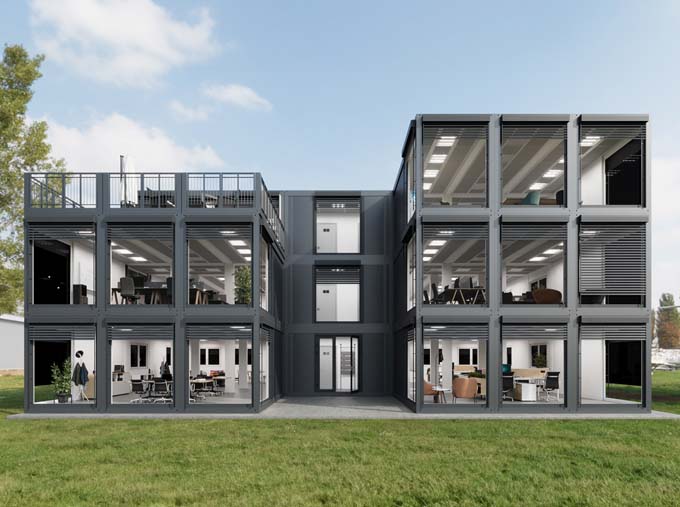Empa study: Fewer energy storage facilities achieve 1.5-degree target faster
Limiting global warming to 1.5 degrees requires the energy system to be restructured as quickly as possible. But the speed of this transformation is physically limited. An Empa study now calculates the influence of energy storage systems on the maximum possible transition speed - and thus also on the probability of successfully mastering the climate crisis.

The construction of renewable energy systems itself requires a lot of energy: The production of solar panels and batteries is resource-intensive and causes CO2 emissions on a considerable scale. This means that in order to make the transition to a climate-friendly society, it is first necessary to invest a lot of predominantly fossil energy - and to do so as quickly as possible. Because the bottom line is that this will result in fewer climate gases entering the environment overall.
Energy storage systems play an important role in energy transition scenarios - from batteries to pumped storage power plants to synthetic fuels from renewable sources. If they are built and operated in addition to the solar infrastructure on roofs and facades, the energy demand for the transition increases. Scenarios developed by researchers in Empa's Technology and Society department now show that the more storage facilities that are built, the longer the system transformation will take and the higher the total greenhouse gas emissions will be - depending, of course, on the technologies used and on technological progress.
Calculate chances of success
One example: If we wanted to maintain our current energy use habits, about 60 percent of the world's solar energy output would need to be stored - and the bottom-line storage would need to be large enough to supply the world's entire energy needs for about three weeks. Even under extremely optimistic assumptions, this scenario would exceed the 1.5 degree target with at least a 50 percent probability.
However, the need for storage can be significantly reduced by technical measures. For example, the electrification of building heating systems and intelligent appliance controls make it possible in many cases to flexibilize the demand pattern without having to change energy behavior. Such a scenario could already roughly halve the storage requirement.
For the 1.5 degree target, this would mean: In the best case, there is only a 14 percent chance that it will be exceeded - namely, if efficient pumped-storage power plants with high efficiency are used for energy storage. If, on the other hand, a lot of energy were stored in synthetic fuels at today's technical level with low efficiency, the target would hardly be achievable. By comparison, an energy industry that requires hardly any storage could reduce the probability of exceeding 1.5 degrees to 3 percent.
The sunflower as a model
Energy storage systems therefore have a fundamental influence on the dynamics of the transition and its climate consequences: The less storage is needed, the faster we can dispense with fossil fuels. Admittedly, this requires a paradigm shift: away from a demand-driven energy system in which everyone can need energy when they want it. And toward an energy system that follows the path of the sun.
The basic idea of this "sunflower society": Consumers such as industry, transport, households and public institutions concentrate their energy-intensive activities, if at all possible, around midday and in the summer. At night and in winter, on the other hand, they are minimized.
Conceivable measures would be, for example, to replace the "active" energy demand with "passive" energy demand. For example, promoting efficient building insulation instead of heating systems, which have a particularly negative impact in winter. Although the production of such insulation requires energy, it could be produced in times of energy surplus. Or switch to means of transport such as trolley buses, which do not require storage. Simple changes in behavior can also make a contribution, for example by running the washing machine at midday.
Conclusion: If implemented consistently, the sunflower society would have the potential to significantly minimize climate risks and considerably accelerate the transformation of the energy system. This would not only help protect the climate, but also conserve resources and reduce costs, because energy storage systems are also material-intensive and expensive.
Source: Empa
Study "Sunflower society
In the Empa study, the global restructuring of the energy system was investigated by taking into account feedbacks in the energy balance. In the model developed, the global energy system was computationally combined into two parts, so-called machines: a fossil machine, i.e. today's energy system, and a solar machine, the future system including energy storage. Both machines supply energy to society. But the solar machine must first be created or built by using additional energy. Depending on the amount of fossil investment, the reinvestment of solar energy during the transition, the storage technology considering the technical progress as well as the size of the required storage, scenarios with different fast transition phases and CO2 emissions result. The study was funded by the Swiss National Science Foundation (SNSF) as part of the "Laboratory for Applied Circular Economy" project in the National Research Programme (NRP) 73 "Sustainable Economy".









